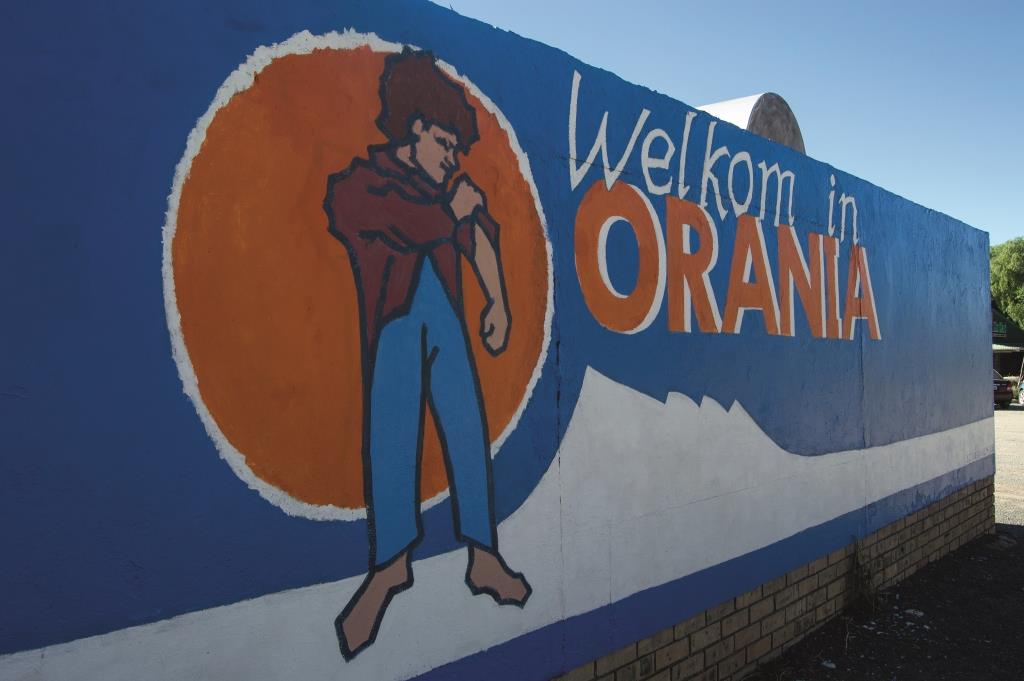I had heard stories and seen pictures of this town, thinking I would never set foot in such a place. But nobody can predict what is destined; I was assigned to photograph Orania, a small, whites-only Afrikaner town 155 kilometers away from Kimberly, in South Africa’s Northern Cape province.
We see Klein Reus (a small boy rolling up his sleeves) who is a mascot painted on the town’s sign. That is how we know we’ve arrived. I look for a petrol station where we are to meet our contact; James Kemp, originally from Pretoria.
We convoy into the town to a restaurant close to the Orange River. Feeling uncomfortable, I park the car facing the exit to make it easier to escape should things turn sour.
We meet with Kemp and young Joost Strydom who will show us around Orania, but first its dinner. The restaurant’s menu is in Afrikaans, and amounts are without the rand sign but with an O and a line across it, representing Ora (Oranian currency).
As a Soweto born and bred youth, I am out my comfort zone for a minute and my street smarts are left behind in the little Kia Picanto we parked. However, the local beer is great, something I can relate to with the locals, and the food is decent.
Soon after, it was back to Kimberly and we are told to drive slowly and keep the interior lights on so that kudus jump over the car and not towards the headlights. Strange as it sounds, we do as we are told. It’s a long drive back.
Day two, we arrive in Orania at 8AM, just in time for our breakfast meeting at Die Pienk Zebra coffee shop. I realize the waiters are not black, something unusual in the rest of South Africa. I had the usual toasted brown bread, bacon and half-done eggs, only this time it comes with dried lamb fat and a portion of pap. It was filling and tasty.
Then it was time to meet Carel Boshoff, the son of Orania’s founder and grandson of former South African Prime Minister Hendrik Verwoerd. He says the town was made to preserve the Afrikaans culture; I find it hard to believe, I think they were running away from us.
But before all that, young Strydom takes a picture of me sitting on top of large letters that spell out Orania, which I post on social media. I got a lot of questions and a few racial comments and it was an honor telling them the place is not as bad as they think.
After a short tour, we return to the restaurant for lunch. A group of teens laugh aloud while enjoying their milkshakes, a young couple kiss over a beer and a soft drink, while a man behind them looks at us without blinking, making us uncomfortable. It seems he doesn’t like the idea of black people sitting in their restaurant, indulging in Afrikaner food. That soon changes my mind about the place, but I decide that not all the locals can be racist.
We drive around the town again and I get a better feel about the place. Most here are working class, not the middle and upper class I assumed I would encounter.
Lastly we visit the Verwoerd Museum, the house where Betsie, the wife of the late apartheid leader Hendrik Verwoerd, lived. I don’t like the idea of going in, I fear we might get locked in and the community will come and make toast of us. We go into Betsie’s bedroom and the stale odour that hits me immediately makes me want to leave the house, and the town.
As we drive away, I stop the car to photograph the Orania sign, wondering if these people are genuinely not racist or if it was just an act for the media.
